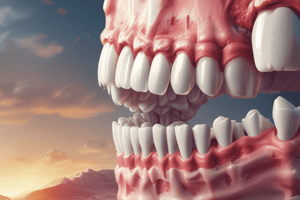Podcast
Questions and Answers
What is the primary purpose of brushing teeth twice daily with fluoride toothpaste?
What is the primary purpose of brushing teeth twice daily with fluoride toothpaste?
- To prevent cavities and gum disease (correct)
- To whiten teeth
- To freshen breath
- To strengthen tooth enamel
Which type of tooth is primarily responsible for tearing and ripping food?
Which type of tooth is primarily responsible for tearing and ripping food?
- Canines (correct)
- Incisors
- Molars
- Premolars
At what age do permanent teeth typically begin to emerge?
At what age do permanent teeth typically begin to emerge?
- 12-14 years
- 6 months
- 5-7 years (correct)
- Birth
What is the primary function of the molars?
What is the primary function of the molars?
Which mineral is primarily responsible for the hardness of tooth enamel?
Which mineral is primarily responsible for the hardness of tooth enamel?
What is the primary function of premolars?
What is the primary function of premolars?
How many premolars are there in total?
How many premolars are there in total?
Which of the following is a symptom of gum disease?
Which of the following is a symptom of gum disease?
What is the primary cause of tooth decay?
What is the primary cause of tooth decay?
What is the main function of molars?
What is the main function of molars?
Study Notes
Dentition: Understanding Your Teeth's Development, Types, Functions, and Common Issues
Oral Hygiene
Maintaining good oral hygiene is crucial for overall health. Daily brushing, flossing, and regular dental checkups prevent cavities, gum disease, and other dental problems. Brush twice daily with fluoride toothpaste and clean between teeth once a day with dental floss. Use antibacterial mouthwash to kill bacteria and freshen breath.
Development of Teeth
Teeth develop from tiny cells called odontoblasts that create dentin, which forms the inner layer of teeth. Enamel, the hard outer layer, is created by an organic mineral called hydroxyapatite. Baby teeth typically start appearing around six months old, while permanent teeth emerge between ages five and seven.
Types of Teeth
Human adults have three types of teeth: incisors, canines, and molars. Incisors are located near the front of your mouth, used for biting and cutting food. Canines are sharp, pointed teeth used for ripping and tearing. Molars, also known as premolars, are larger teeth at the back of your mouth that grind and crush food.
Functions of Each Tooth Type
Incisors
These eight teeth, four on top and four on bottom, help you bite and cut food. Upper and lower central and lateral incisors are most visible when you smile.
Canines
Four sharp, pointed teeth located on either side of the incisors are known as canines. They serve for gripping and tearing food, especially when chewing tough foods like meat.
Premolars
Also called bicuspid teeth, there are eight premolars in total. Four are upper premolar and four are lower premolar. These teeth have two points or "cusps" on the crown's biting surface. Their primary function is grinding and crushing food during chewing.
Molars
Three types of molars exist: incisors, canines, and first molars (also known as premolars). They have multiple points or "cusps" on the crown's biting surface. Molars are responsible for grinding and crushing food during chewing, as well as functioning in the process of swallowing.
Common Dental Issues
Tooth Decay
Tooth decay, or cavities, occurs when the protective enamel on the tooth is worn away, exposing the underlying dentin. Decay can lead to tooth pain, infection, and tooth loss if left untreated.
Gum Disease
Gum disease, also known as periodontal disease, is an infection of the tissues surrounding the teeth. Symptoms include red, swollen, or bleeding gums. If left untreated, it can lead to tooth loss and other health complications.
Sensitive Teeth
Sensitive teeth may cause discomfort or pain due to exposure of tooth surfaces caused by gum recession, enamel erosion, or cracking of the teeth, resulting in exposed dentin.
Understanding dentition allows individuals to take proper care of their oral health, recognize common dental issues early, and maintain a healthy, functioning smile throughout life.
Studying That Suits You
Use AI to generate personalized quizzes and flashcards to suit your learning preferences.
Description
Learn about the development, types, functions, and common issues related to teeth. Understand the importance of oral hygiene, tooth development process, different types of teeth, their functions, and common dental problems like tooth decay, gum disease, and sensitive teeth.




